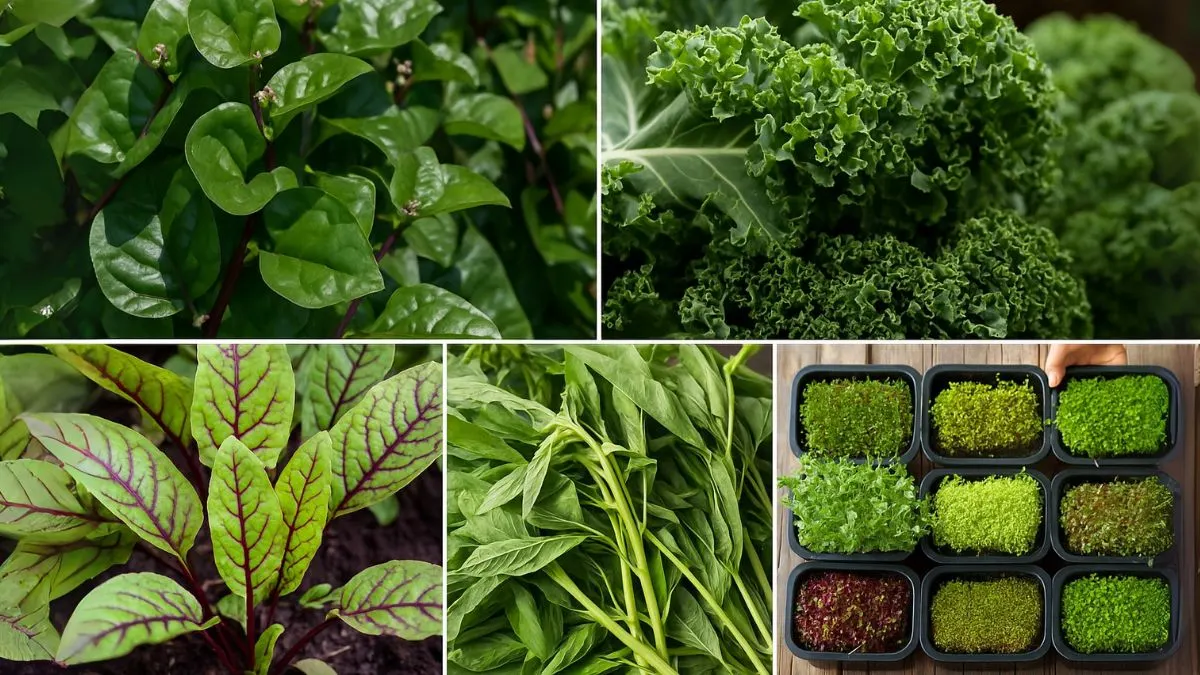If you think leafy greens start and end with ordinary spinach, think again. Home gardens across the world, from Canada to the USA, are now embracing unique edible leaf plants that combine nutrition, flavor, and beauty. Many of these are as nutrient-dense as kale, spinach, and microgreens while offering a fresh twist for your recipes.
I remember when I first discovered Malabar Spinach (Basella alba). Its glossy vines wrapped around my balcony railing, and soon, I was enjoying leafy harvests all summer long. That experience inspired me to explore more unusual greens, and today, I’ll share five that you’ll want to grow in your own garden.
-
Malabar Spinach (Basella alba)

Let’s start with the superstar. Malabar Spinach (Basella alba) isn’t a true spinach, but it’s a perennial edible that thrives in warm weather where regular spinach struggles. Its fleshy, heart-shaped leaves have a slightly mucilaginous texture, perfect for stir-fries, curries, and soups.
- Climate: Loves hot and humid weather.
- Growth: Climbs beautifully on trellises, reaching up to 10 feet.
- Nutrition: High in vitamins A and C, calcium, and iron.
This plant is famous worldwide, and if you’re in a colder region like Canada, you can grow it in containers and bring it indoors during frost.
-
Kale
Kale has become a global superfood, and for good reason. It’s easy to grow, hardy, and packed with antioxidants. Unlike Malabar Spinach (Basella alba), kale prefers cooler climates, making it perfect for spring and fall gardens in the USA and Canada.
- Varieties: Curly kale, Tuscan (Lacinato), and Red Russian.
- Nutrition: Dense in vitamins A, K, and C, plus fiber.
- Use: Great for smoothies, salads, chips, or sautés.
Many gardeners love kale because it continues producing fresh leaves long after harvesting begins.
Also Read: Propagating Snake Plants in Water & Soil—Which Works Best?
-
Perennial Edible Greens – Sorrel
Sorrel is a lesser-known perennial edible that deserves more attention. Its tangy, lemony flavor makes it a fantastic addition to salads, soups, and sauces. Once planted, it comes back year after year with very little maintenance.
- Climate: Tolerates both sun and partial shade.
- Soil: Well-draining and slightly acidic.
- Nutrition: High in vitamin C and antioxidants.
I once grew sorrel in a corner of my garden, and it became a secret weapon for refreshing summer salads.
-
Spinach
Classic spinach still holds its rightful place in the edible leaf hall of fame. Unlike Malabar Spinach, it thrives in cool seasons, making it an excellent option for spring and fall gardens in North America.
- Growth: Fast-growing annual; ready to harvest in just 6–8 weeks.
- Nutrition: Iron-rich and loaded with vitamins.
- Tip: Plant in succession every two weeks for a steady harvest.
Spinach’s versatility in cooking—from creamy pastas to fresh salads—makes it a must-have in every home garden.
-
Microgreens
If space is an issue, turn to microgreens. These are baby versions of plants like spinach, kale, arugula, and even sunflowers. They’re incredibly nutrient-dense, often containing more vitamins and antioxidants than their mature counterparts.
- Growth: Ready to harvest in 2–3 weeks.
- Growing Medium: Soil trays or even hydroponics.
- Use: Sprinkle on soups, salads, or sandwiches for an instant nutrient boost.
I’ve grown trays of microgreens on my windowsill, and it’s always satisfying to cut a fresh batch right before dinner.
Also Read: The Best Berries to Grow in Containers
Quick Comparison Table
Plant |
Climate Preference |
Growth Type |
Nutrition Highlights |
Best Use |
Malabar Spinach (Basella alba) |
Hot & humid |
Perennial edible vine |
Vitamins A & C, calcium, iron |
Curries, soups, stir-fries |
Kale |
Cool |
Biennial, grown annual |
Vitamins A, K, C, antioxidants |
Smoothies, chips, salads |
Sorrel |
Moderate |
Perennial edible herb |
Vitamin C, antioxidants |
Salads, soups, sauces |
Spinach |
Cool |
Fast-growing annual |
Iron, vitamins, folate |
Salads, pasta, sautés |
Microgreens |
Indoors/anywhere |
Tray-grown seedlings |
Nutrient-dense, antioxidants |
Soups, salads, sandwiches |
Adding variety to your home garden doesn’t just make meals more interesting—it boosts your nutrition and brings beauty to your space. From the climbing elegance of Malabar Spinach (Basella alba) to the humble trays of microgreens, these plants are famous worldwide for their taste and health benefits.
If you’ve only ever grown traditional spinach, it’s time to experiment with these unique edible leaf plants. Whether you’re in Canada, the USA, or anywhere else, your garden (and your kitchen) will thank you.
So, which one will you plant first—perennial edibles like sorrel or quick-growing microgreens?






